Wood jointers are an indispensable tool in the world of woodworking. They are used to flatten the faces and edges of a piece of wood, making it perfectly square and ready for further processing. This tool is essential for any woodworking project that requires precision and accuracy, such as furniture making or cabinetry.
The purpose of this article is to provide a comprehensive guide on wood jointers. It aims to educate readers about the importance of wood jointers, their types, key features to consider when buying one, safety features, top brands, budget considerations, and maintenance and care. By the end of this article, readers should have a solid understanding of wood jointers and be able to make an informed decision when purchasing one.
Whether you’re a professional woodworker or a DIY enthusiast, understanding the functionality and importance of wood jointers is crucial. This guide will provide you with all the necessary information to help you choose the right wood jointer for your needs.
Our Top Wood Jointer Picks
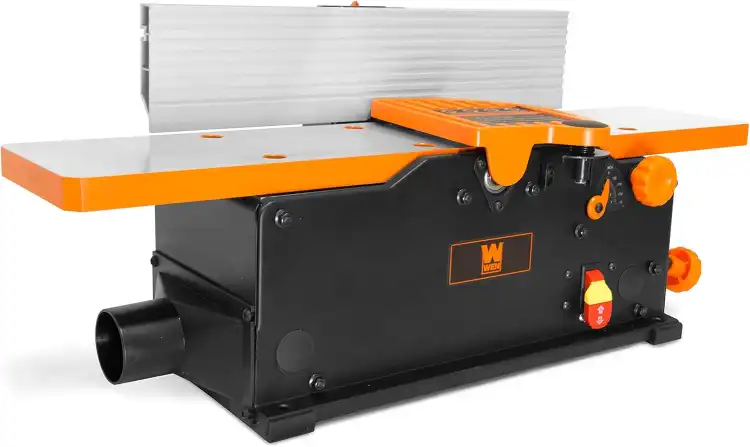
WEN JT630H 10-Amp 6-Inch Spiral Benchtop Jointer
Check on AmazonKey Specs
- Motor: 10-amp
- Table Size: 30″ x 6″
- Fence Size: 19-3/4″ x 4-1/4″
- Cutterhead: Spiral with 12 HSS blades
- Depth of Cut: 0 to 1/8 inch per pass
The WEN JT630H 10-Amp 6-Inch Spiral Benchtop Jointer is a fantastic addition to any workshop. The spiral cutterhead system, equipped with 12 staggered HSS blades, ensures an ultra-fine finish, providing smooth cuts every time. Its spacious 30-by-6-inch table offers ample support for larger projects. I appreciate the adjustable fence that bevels up to 45 degrees, allowing for greater versatility. This jointer is easy to operate and delivers professional-level results, making it perfect for both beginners and seasoned woodworkers.
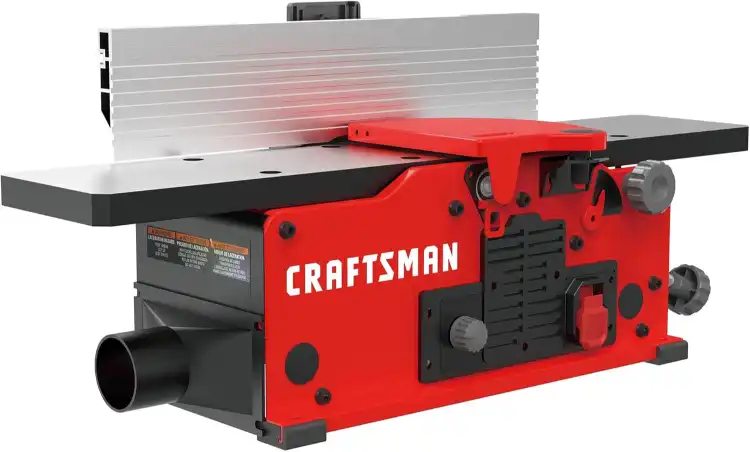
CRAFTSMAN Benchtop Jointer
Check on AmazonKey Specs:
- Motor: 10-amp
- Speed Range: 6,000 to 11,000 RPM
- Fence Size: 4-1/4″ center-mounted
- Cutterhead: Two-knife system with Jackscrew adjustment
- Max Cuts per Minute: 22,000
The CRAFTSMAN Benchtop Jointer is a solid, reliable tool for any woodworking enthusiast. I particularly like its variable speed feature, ranging from 6,000 to 11,000 RPM, which allows you to tailor the speed to different materials for precise cuts. The two-knife cutter head, with a Jackscrew knife leveling system, makes blade adjustments incredibly simple. Its 10-amp motor provides consistent power, even for tough hardwoods. The center-mounted fence enhances cutting accuracy, ensuring professional results every time.
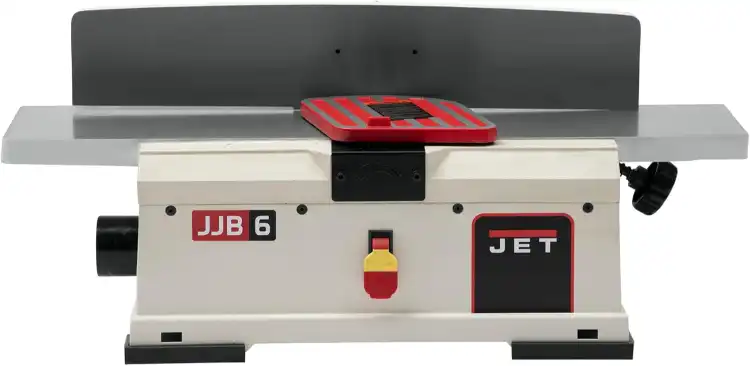
JET 6-Inch Benchtop Jointer, Helical Cutterhead
Check on AmazonKey Specs:
- Motor: 1 HP, 15-amp
- Cutterhead: True helical, 14 indexable four-sided carbide blades
- Fence: Fully-adjustable with +/- 45° tilt
- Dimensions: 32.75″L x 15″W x 11.5″H
- Speed: 10,000 RPM
The JET 6-Inch Benchtop Jointer is an impressive tool, featuring a helical cutterhead with 14 four-sided carbide blades that provide a clean, smooth finish with minimal noise. The heavy-duty cast iron tables and fence offer durability and stability, ensuring accuracy with each pass. Its 1 HP motor provides ample power for tough cuts, while the fully-adjustable fence with locking stops makes beveling easy. Plus, the internal blower keeps the work area clean and free of debris for better visibility.
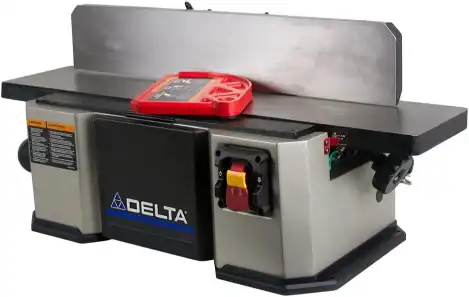
6 in. Midi‑Bench Jointer
Check on AmazonKey Specs:
- Motor: 12 Amps, 120V, 60 Hz
- Max Depth of Cut: 1/8 inch
- Cutterhead Speed: 10,000 RPM
- Max Width of Cut: 6 inches
- Weight: 76 lbs
The Delta 6-inch Midi-Bench Jointer is a solid addition to any workshop, offering a reliable and efficient tool for woodworking. The durable cast iron construction provides excellent stability, reducing vibrations and ensuring smooth, accurate cuts. I particularly appreciate the heavy-duty fence support system, which ensures precise jointing, and the built-in dust blower that keeps the workspace clean and prevents clogs. With a 1/8-inch max depth of cut and a powerful 12-amp motor, this jointer performs well for most DIY and professional tasks.
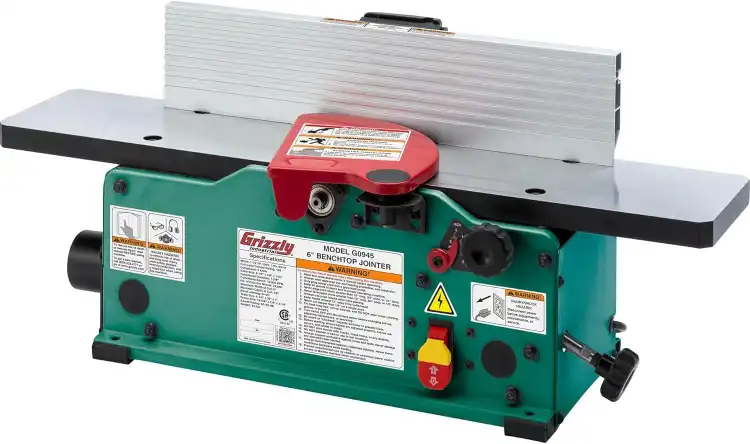
Grizzly Industrial G0945 6inches Benchtop Jointer
Check on AmazonKey Specs:
- Cutterhead: Straight-knife with 2 SK5 steel knives
- Tables: Cast aluminum infeed and outfeed
- Dust Collection: Built-in 2-1/2″ dust port
- Infeed Table Adjustment: Height lock included
- Included: Two push blocks
The Grizzly Industrial G0945 6-inch Benchtop Jointer is a standout for its precision and efficiency in a compact form. The straight-knife cutterhead with two SK5 steel knives ensures clean cuts and durability, while the cast aluminum infeed and outfeed tables offer excellent stability. The built-in dust collection system with a 2-1/2″ port helps maintain a clean workspace, and the infeed table height adjustment lock adds convenience for accurate adjustments. Two push blocks are also included for safety during use.
Understanding Wood Jointers
A wood jointer, also known as a planer, is a tool used in woodworking to make a piece of wood flat and square. It works by removing material from the wood’s surface, thereby straightening and squaring it. The jointer has a set of blades, or knives, that spin at high speed to cut the wood.
Wood jointers play a crucial role in woodworking. They are used to prepare the wood for further processing, such as cutting, shaping, or assembling. Without a jointer, it would be challenging to achieve a perfectly flat and square piece of wood, which is essential for many woodworking projects.
Moreover, wood jointers help improve the quality of your work. They ensure that the wood pieces fit together perfectly, resulting in a more professional and polished final product. Whether you’re building a piece of furniture or a wooden structure, a wood jointer can significantly enhance the quality of your work.
Types of Wood Jointers
There are several types of wood jointers available in the market, each with its own set of features and benefits. The most common types are benchtop jointers, closed stand jointers, open stand jointers, and long bed jointers.
Benchtop jointers are compact and portable, making them ideal for small workshops or home use. They are also relatively affordable, making them a popular choice for beginners or hobbyists. Despite their small size, benchtop jointers can deliver excellent results, especially for small to medium-sized projects.
Closed stand jointers, on the other hand, are larger and more powerful. They are designed for heavy-duty use and can handle larger pieces of wood. These jointers are typically used in professional woodworking shops. They are sturdy, durable, and offer excellent performance, but they are also more expensive than benchtop jointers.
Open stand jointers are a middle-ground option between benchtop and closed stand jointers. They offer a good balance of size, power, and price, making them a popular choice for many woodworkers. Lastly, long bed jointers are designed for working with long pieces of wood. They have extended infeed and outfeed tables, allowing for better support and control when jointing long boards.
Key Features to Consider When Buying a Wood Jointer
When buying a wood jointer, there are several key features to consider. These include the size and weight of the jointer, its power and speed, the design of the fence and table, and the type of cutterhead.
The size and weight of the jointer are important factors to consider, especially if you have limited space in your workshop. Smaller, lighter jointers are easier to move around and store, but they may not be as powerful or capable as larger models. On the other hand, larger jointers can handle bigger pieces of wood and offer better performance, but they are also heavier and take up more space.
The power and speed of the jointer are also crucial. A more powerful jointer can cut through harder types of wood and deliver faster results. However, it’s important to note that more power also means more noise and potentially higher energy consumption. The speed of the jointer, measured in RPM (revolutions per minute), affects how quickly it can cut the wood. Higher speeds result in smoother cuts, but they can also increase the risk of accidents if not handled properly.
The design of the fence and table is another important factor to consider. The fence is used to guide the wood through the jointer, while the table supports the wood during the jointing process. A well-designed fence and table can greatly improve the accuracy and quality of your work.
Finally, the type of cutterhead is an important feature to consider. There are two main types of cutterheads: straight knife and helical. Straight knife cutterheads are the traditional type and are typically cheaper. However, they can be noisy and require regular maintenance. Helical cutterheads, on the other hand, are quieter and require less maintenance, but they are also more expensive.
Detailed Analysis of Key Features
The size and weight of a wood jointer are important considerations for several reasons. First, they affect the jointer’s portability. If you need to move the jointer around your workshop or transport it to different locations, a smaller and lighter model would be more convenient. However, smaller jointers may not be as powerful or capable as larger models, so you need to balance your need for portability with your need for performance.
Second, the size and weight of the jointer affect its stability. Heavier jointers are generally more stable, which can lead to better accuracy and quality of work. On the other hand, lighter jointers may be less stable, especially when working with larger pieces of wood.
Third, the size of the jointer determines the size of the wood it can handle. Larger jointers can accommodate larger pieces of wood, making them suitable for bigger projects. However, if you only work with small pieces of wood or have limited space in your workshop, a smaller jointer may be more practical.
The power and speed of a wood jointer are also crucial factors to consider. A more powerful jointer can cut through harder types of wood and deliver faster results. However, more power also means more noise and potentially higher energy consumption. Therefore, you need to consider your specific needs and preferences when choosing the power and speed of your jointer.
The speed of the jointer, measured in RPM (revolutions per minute), affects how quickly it can cut the wood. Higher speeds result in smoother cuts, but they can also increase the risk of accidents if not handled properly. Therefore, it’s important to choose a jointer with a speed that you can safely and comfortably handle.
The design of the fence and table is another important factor to consider. The fence is used to guide the wood through the jointer, while the table supports the wood during the jointing process. A well-designed fence and table can greatly improve the accuracy and quality of your work. For example, a fence that is easy to adjust and locks securely in place can help you make precise cuts. Similarly, a table that is flat and smooth can ensure that the wood slides easily and evenly through the jointer.
The type of cutterhead is an important feature to consider when buying a wood jointer. There are two main types of cutterheads: straight knife and helical. Straight knife cutterheads are the traditional type and are typically cheaper. However, they can be noisy and require regular maintenance. Helical cutterheads, on the other hand, are quieter and require less maintenance, but they are also more expensive. Therefore, you need to consider your budget, noise tolerance, and maintenance preferences when choosing the type of cutterhead.
Safety Features in Wood Jointers
Safety is a paramount concern when working with wood jointers. These machines have fast-spinning blades that can cause serious injuries if not handled properly. Therefore, it’s important to choose a jointer with adequate safety features.
One of the key safety features to look for is a safety switch. This is a switch that allows you to quickly and easily turn off the jointer in case of an emergency. Some jointers have a paddle-style safety switch, which can be hit with your knee or hip, allowing you to keep both hands on the wood at all times.
Another important safety feature is a blade guard. This is a cover that protects you from the jointer’s blades when they are not in use. Some jointers have a self-retracting blade guard, which automatically covers the blades when the jointer is not in use, adding an extra layer of safety.
Finally, a dust collection system is a useful safety feature. Jointing wood produces a lot of dust, which can be harmful if inhaled. A jointer with a good dust collection system can help keep your workshop clean and safe.
Top Brands for Wood Jointers
There are several top brands for wood jointers, each offering a range of models with different features and prices. Some of the most popular brands include Delta, Jet, Grizzly, and Powermatic.
Delta is a well-known brand that offers a range of high-quality wood jointers. Their jointers are known for their durability, performance, and ease of use. They offer both benchtop and floor-standing models, catering to different needs and budgets.
Jet is another popular brand that offers a variety of wood jointers. Their jointers are praised for their power, precision, and innovative features. They offer both straight knife and helical cutterhead models, giving you a choice depending on your preferences.
Grizzly is a brand known for its heavy-duty wood jointers. Their jointers are built to last and can handle large pieces of wood with ease. They offer a range of models, from compact benchtop jointers to large, industrial-grade machines.
Powermatic is a premium brand that offers high-end wood jointers. Their jointers are known for their superior performance, precision, and durability. They are more expensive than other brands, but they are worth the investment if you are a professional woodworker or serious hobbyist.
Budget Considerations
Wood jointers can vary greatly in price, depending on their size, power, features, and brand. Therefore, it’s important to consider your budget when choosing a wood jointer.
On the lower end of the price range, you can find small, benchtop jointers for a few hundred dollars. These jointers are suitable for small projects and hobbyists. They may not have as much power or as many features as more expensive models, but they can still deliver good results for small to medium-sized projects.
In the mid-range price bracket, you can find larger, more powerful jointers with more features. These jointers are suitable for serious hobbyists and small professional workshops. They offer better performance and more versatility than lower-priced models, but they are also more expensive.
On the high end of the price range, you can find industrial-grade jointers with top-of-the-line features. These jointers are designed for professional use and can handle large, heavy-duty projects. They offer superior performance and durability, but they are also significantly more expensive.
When considering your budget, it’s important to balance quality and affordability. While it’s tempting to go for the cheapest option, remember that you often get what you pay for. A cheap jointer may not last as long or perform as well as a more expensive model. Therefore, it’s worth investing in a good-quality jointer that can deliver reliable performance and last for many years.
Maintenance and Care for Wood Jointers
Proper maintenance and care are crucial for keeping your wood jointer in good working condition. Regular cleaning and inspection can help prevent problems and extend the life of your jointer.
After each use, clean the jointer to remove any dust or debris. This can prevent buildup that can affect the jointer’s performance. Use a soft brush or cloth to clean the jointer, and avoid using water or other liquids that can cause rust.
Regularly inspect the jointer for any signs of wear or damage. Check the blades for any nicks or dullness, and replace them if necessary. Also, check the fence and table for any misalignment or instability. If you notice any problems, fix them as soon as possible to prevent further damage.
Proper storage is also important for maintaining your wood jointer. Store the jointer in a dry, clean place to prevent rust and dust buildup. If possible, cover the jointer when not in use to protect it from dust and moisture.
Finally, remember to replace parts as necessary. Over time, parts like blades, belts, and bearings can wear out and need to be replaced. Regularly replacing these parts can keep your jointer running smoothly and efficiently.
Conclusion
In conclusion, a wood jointer is an essential tool for any woodworking project that requires precision and accuracy. Understanding the functionality and importance of wood jointers, as well as the different types and key features, can help you choose the right jointer for your needs.
When buying a wood jointer, consider factors like size, weight, power, speed, fence and table design, and cutterhead type. Also, look for safety features like safety switches, blade guards, and dust collection systems. Consider your budget and balance quality and affordability. Finally, remember to properly maintain and care for your jointer to ensure its longevity and performance.
Choosing the right wood jointer can significantly enhance the quality of your woodworking projects. Whether you’re a professional woodworker or a DIY enthusiast, a good wood jointer is a worthwhile investment for perfectly flat and square wood surfaces.
FAQ
What is a wood jointer used for?
A wood jointer is used to flatten the faces and edges of a piece of wood, making it perfectly square and ready for further processing. It’s an essential tool for any woodworking project that requires precision and accuracy.
What are the different types of wood jointers?
The most common types of wood jointers are benchtop jointers, closed stand jointers, open stand jointers, and long bed jointers. Each type has its own set of features and benefits, and the best one for you depends on your specific needs and preferences.
What should I look for when buying a wood jointer?
When buying a wood jointer, consider factors like size, weight, power, speed, fence and table design, and cutterhead type. Also, look for safety features like safety switches, blade guards, and dust collection systems.
How do I maintain and care for a wood jointer?
A: Proper maintenance and care for a wood jointer include regular cleaning and inspection, proper storage, and replacement of parts as necessary. Regular maintenance can help prevent problems and extend the life of your jointer.
